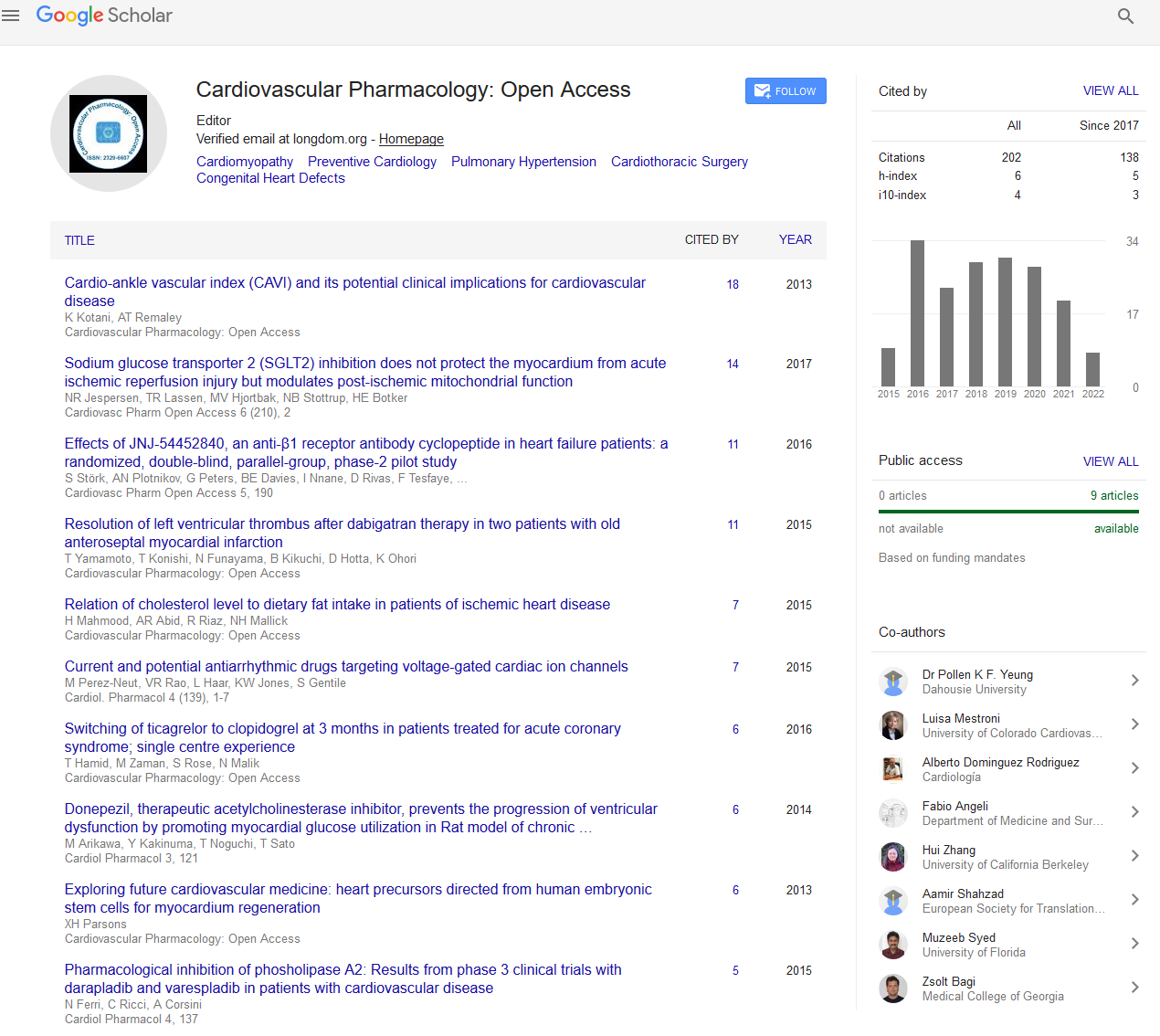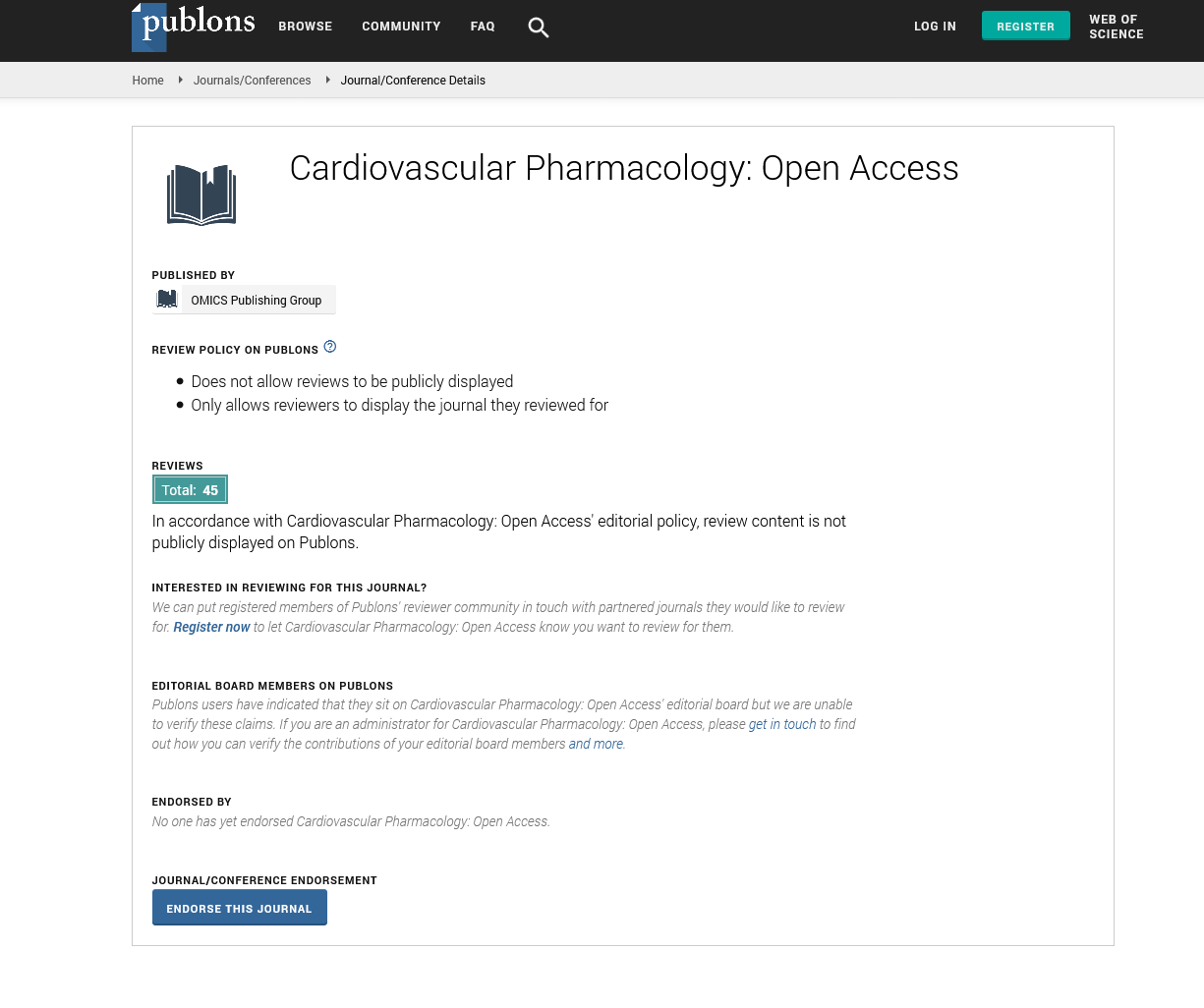Indexed In
- Open J Gate
- Cosmos IF
- RefSeek
- Hamdard University
- EBSCO A-Z
- OCLC- WorldCat
- Publons
- Geneva Foundation for Medical Education and Research
- Euro Pub
- Google Scholar
Useful Links
Share This Page
Journal Flyer

Open Access Journals
- Agri and Aquaculture
- Biochemistry
- Bioinformatics & Systems Biology
- Business & Management
- Chemistry
- Clinical Sciences
- Engineering
- Food & Nutrition
- General Science
- Genetics & Molecular Biology
- Immunology & Microbiology
- Medical Sciences
- Neuroscience & Psychology
- Nursing & Health Care
- Pharmaceutical Sciences
Perspective - (2025) Volume 14, Issue 2
Vasodilators in the Treatment of Pulmonary Arterial Hypertension
Isabella Costa*Received: 29-May-2025 Editor assigned: 31-May-2025 Reviewed: 14-Jun-2025 Revised: 20-Jun-2025 Published: 28-Jun-2025
Description
Pulmonary Arterial Hypertension (PAH) is a progressive and debilitating disorder characterized by persistently elevated pressure within the pulmonary arteries. This increased pressure results from pathological changes in the pulmonary vasculature, including vascular remodeling, smooth muscle proliferation and endothelial dysfunction. Over time, these changes lead to increased pulmonary vascular resistance, placing a significant strain on the right ventricle of the heart, which can culminate in right heart failure and premature mortality if left untreated. Given the severity of the disease, pharmacological treatment strategies have primarily aimed at promoting vasodilation, improving hemodynamics and slowing the progression of vascular damage to enhance patient survival and quality of life.
The earliest pharmacological interventions in PAH involved the use of prostacyclin analogues, such as epoprostenol. These agents function by stimulating the production of Cyclic Adenosine Monophosphate (cAMP), which induces potent vasodilation of the pulmonary arteries and inhibits platelet aggregation, thereby helping to maintain vascular patency. Continuous intravenous infusion of epoprostenol was a landmark advancement, dramatically improving survival rates in patients with advanced disease. However, the need for continuous infusion via central venous catheters, along with associated risks and side effects such as infections and catheter-related complications, limited its widespread use. These challenges spurred the development of newer prostacyclin formulations like treprostinil and iloprost, which offer more flexible routes of administration, including subcutaneous, inhaled and intravenous delivery, thereby improving patient convenience and tolerability.
Another critical class of drugs in PAH management is Endothelin Receptor Antagonists (ERAs), which include bosentan, ambrisentan and macitentan. Endothelin-1 is a potent vasoconstrictor and pro-proliferative peptide that plays a central role in the pathogenesis of PAH. By blocking endothelin receptors, ERAs reduce pulmonary vascular resistance and alleviate vasoconstriction. Extensive clinical trials have demonstrated their efficacy in both early and late stages of PAH, showing improvements in exercise capacity, hemodynamics and delay in clinical worsening.
Phosphodiesterase type 5 (PDE5) inhibitors, such as sildenafil and tadalafil, represent another important therapeutic option. These agents work by inhibiting the breakdown of Cyclic Guanosine Monophosphate (cGMP), thereby enhancing the nitric oxide-mediated vasodilation of pulmonary vessels. Their oral administration route, combined with a generally favorable safety and tolerability profile, has made PDE5 inhibitors widely adopted in clinical practice. They are especially effective when used as part of combination therapy alongside other drug classes.
Modern treatment strategies for PAH emphasize combination therapy targeting multiple pathogenic pathways simultaneously. The AMBITION trial, for example, demonstrated that initial combination therapy with ambrisentan and tadalafil yielded significantly better clinical outcomes than either drug alone, including reductions in hospitalization rates and disease progression. This paradigm shift from monotherapy to multidrug regimens reflects a deeper understanding of the complex mechanisms driving PAH and the benefits of a multifaceted therapeutic approach.
Despite significant advances in pharmacotherapy, PAH remains a life-threatening disease requiring lifelong treatment and careful monitoring. Patients frequently experience adverse effects, including hypotension, flushing, headaches and gastrointestinal disturbances. Furthermore, the high cost of many PAH medications presents a substantial barrier, especially in low- and middle-income countries, where access to advanced therapies is often limited. This disparity in availability highlights the need for broader healthcare policy interventions to improve global access to effective PAH treatments. Ongoing research continues to explore novel therapeutic targets, including Soluble Guanylate Cyclase (sGC) stimulators and agents aimed at reversing vascular remodeling. Riociguat, an sGC stimulator, has already gained regulatory approval and offers a valuable alternative for patients who have an inadequate response to PDE5 inhibitors or ERAs. By directly stimulating sGC, riociguat enhances the nitric oxide signaling pathway, leading to improved vasodilation and reduced pulmonary arterial pressure.
In addition to pharmacological innovation, efforts are underway to develop biomarkers for earlier diagnosis and to better predict treatment responses, which would enable more personalized and effective management of PAH. The integration of multidisciplinary care, involving cardiologists, pulmonologists and specialized nurses, is crucial to optimize treatment adherence and monitor disease progression. In summary, the development and refinement of vasodilator therapies have substantially improved the outlook for patients with pulmonary arterial hypertension. While a definitive cure remains elusive, the availability of multiple pharmacological classes targeting different disease pathways provides clinicians with a versatile arsenal to extend survival and enhance quality of life. Continued advances in drug development, along with efforts to improve access and personalized care, hold promise for further progress against this challenging condition.
Citation: Costa I (2025) Vasodilators in the Treatment of Pulmonary Arterial Hypertension
Copyright: © 2025 Costa I. This is an open access article distributed under the terms of the Creative Commons Attribution License, which permits unrestricted use, distribution AND reproduction in any medium, provided the original author and source are credited.


